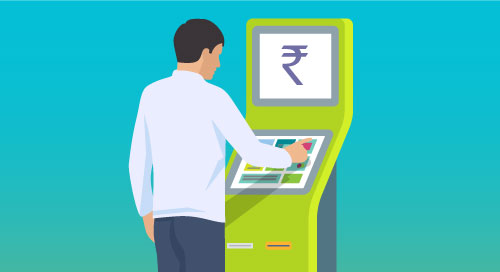Fill form to unlock content
Error - something went wrong!
Your content is just a step away. Please submit below.
Thank you!
“Bank on Wheels” and Edge Computing Serve Rural Communities

Think about the last time you withdrew money from an ATM, used a line of credit, or made a deposit. Most of us take these essential financial services for granted. But millions of rural citizens worldwide don’t have a bank account, and when they do, the convenience of branch banking is not available.
“It’s not cost-effective for banks to open new branches in remote locations,” says Amit Jain, Managing Director of Bits & Bytes, a smart kiosk and digital signage specialist. “And banks in rural areas often face infrastructure problems like power cuts and network outages.”
When people can’t get to the bank, it’s not merely an inconvenience. It’s also an issue of equity when citizens can’t fully participate in the wider economy. But a new kind of edge solution addresses this problem in a surprising way: bringing the bank branch to the people.
Powered by edge computing hardware and telecommunications networks, Bits & Bytes developed a “Bank on Wheels” that is already improving access to financial services in remote communities in India, and is poised to enter other markets around the world.
Rural Branch Banking in Action
A Bits & Bytes mobile branch deployment in India is an excellent example of how these solutions can help. Maharashtra state is one of India’s most populated and heavily industrialized regions. But more than 50% of the state’s population lives in rural areas, leaving many citizens without access to the services their urban counterparts enjoy.
Working with a large national bank, Bits & Bytes developed a solution that can perform many functions of a traditional branch and can be driven from location to location as needed.
The heart of the system is a #digital kiosk that runs on rugged, edge-friendly computing #hardware. Bits & Bytes via @insightdottech
The heart of the system is a digital kiosk that runs on rugged, edge-friendly computing hardware and has a built-in camera and fingerprint scanner for biometric authentication and a touchpad for user interaction. The kiosk is installed in a van that can be driven to different rural areas and parked as long as needed.
The system is connected to the bank in two ways. A data card allows it to communicate with the institution’s centralized server via standard cellular networks—and a bank employee can ride along with the driver to help new customers learn how to use the technology and answer questions.
The mobile kiosk helps customers open a new account, obtain a debit card, and perform transactions like cash withdrawals, deposits, loan applications, bill payments, and transfers.
After deployment, the bank on wheels is a resounding success with customers. “Before, some of these people had to pay specialized agents a fee to travel to the nearest branch in person and perform transactions for them,” says Jain. “They were delighted to be able to do their own transactions directly for the first time.”
Ensuring Compliance and Security at the Edge
Financial systems have stringent security and compliance requirements that vary from country to country. Flexible design and edge capabilities help overcome these challenges and make it possible to deploy the solution in many different markets.
For example, the Bits & Bytes solution complies with India’s strict “know-your-customer” laws, using its secure network connection and biometric authentication capabilities. The mobile banking kiosk performs basic biometric scanning and then communicates with a bank server connected to the central government database. After authentication, a pre-filled application form is fetched and needs only to be signed on the touchpad to finish opening the account.
The elegance of the basic design—an edge IPC and modular hardware linked to a central server over a cellular network connection—means that the system immediately becomes a part of the bank’s existing network. This also means that no personal user data is stored at the edge. Everything is kept within the financial institution’s network—with all the data privacy and cybersecurity precautions this implies.
Plus, a mobile branch can easily be adapted to new regions with different data privacy and regulatory requirements. Because those countries’ regulations have already been met by the financial institution, there is no need for extensive customization to the kiosk software.
Bits & Bytes’ technology partnership with Intel is crucial to the solution. “Intel hardware provides an excellent platform for edge computing,” says Jain. “Intel also plays a vital role in product development, helping us to adapt off-the-shelf Intel technologies to bring new products to market.”
Edge Computing Powers Digital Transformation
The ability to solve rural banking shortages and increase the number of customers will likely attract the attention of bank digitization departments and financial industry integrators (SIs).
The rise of edge computing has not only enabled systems like the Bits & Bytes mobile banking kiosks—it also has the potential to tackle tough problems in multiple industries. In the years ahead, expect to see more innovative solutions deployed at the edge, from autonomous mobile robots in agriculture to private 5G networks for mining operations.
The bank on wheels is an excellent example of the current wave of digital transformation at the edge—and AI will open up even more opportunities in the coming years.
“We’re living in an era of rapid technological advancement in nearly every sector—which is why as a company we offer products for so many different verticals,” says Jain. “Five years down the line, when AI and IoT are everywhere, all kinds of people and organizations will be able to enjoy the benefits of digital transformation.”
Edited by Georganne Benesch, Editorial Director for insight.tech.